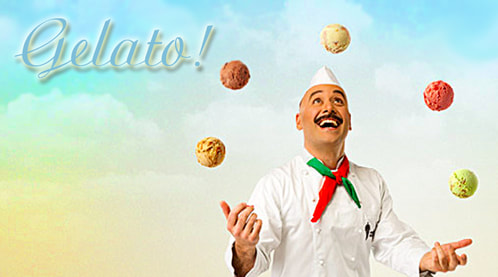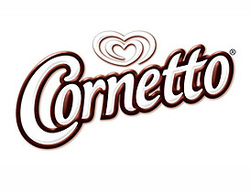Awarded the World’s Best Gelato, Sergio Dondoli’s treats can be found in San Gimignano
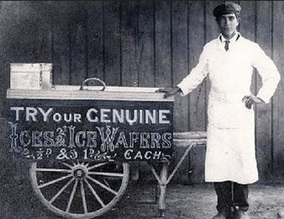
Congelato is the Italian word for frozen, while freddo means cold, reminiscent of how Don Michael Corleone felt about his brother Fredo. Italians often feel freddo even during warmer seasons, a curious paradox given their love for something as cold and frozen as gelato.
If you visit Italy in the summer, you’ll likely want to find ways to stay cool, a concern that Italians seem less preoccupied with. To many Americans, Italian air conditioning feels less cold by comparison, often leaving them feeling quite heated. Interestingly, in winter, temperatures may feel mild to warm to American travelers—while Italians bundle up in scarves and puffy jackets as early as September.
But wait… a revelation is dawning!
Could it be that Italians wear their puffy jackets and scarves because they indulge in gelato every single day, sometimes multiple times? Unlike in the States, ice cream shops in Italy remain open year-round, potentially lowering the average core body temperature of Italians!
Aha! This could explain the stark difference—Americans might better tolerate cold weather because they don’t consume ice cream during the winter months like Italians do.
Perhaps this is why gelaterie start offering cioccolato caldo in winter, helping Italians restore their core body temperature after enjoying a winter gelato treat! (Side note: cioccolato caldo is absolutely divine in Italy, made from real melted chocolate.)
So, what frozen treats await travelers in Italy? Before we dive into the various types of frozen delights, let’s take a brief look into…
History of Ice Cream
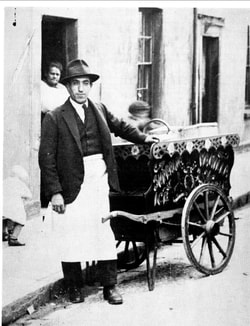
Italian Ice Cream Vendor in Wales.
In fact, officials at Ellis Island began serving ice cream to immigrants, believing it helped make them feel at home. To Italians, this frosty treat was nothing novel. Iced desserts trace their origins back over a millennium, even to ancient Rome, and are common worldwide.
The history of gelato can be traced back to frozen desserts in Sicily, ancient Rome, and Egypt, which was part of the Roman Empire in 30 BC. These desserts were created from snow and ice sourced from the mountains, particularly from volcanoes like Etna and Vesuvius, topped with honey or fruit juices.
Some historical accounts suggest that the Roman Emperor Nero was the first to create a type of sorbet in the first century AD by sending runners along the Appian Way to fetch snow from the mountains to flavor it with honey and wine.
During the Italian Renaissance, the legacy of modern Italian gelato started to evolve dramatically. The Medici family in Florence hosted a contest to find the best frozen dessert. A peasant named Ruggeri, a chicken farmer and self-taught chef, participated, presenting a dessert combining fruit juice and ice, akin to sorbet. Ruggeri’s triumph in the contest granted him fortune and fame, especially when he was brought to France by Caterina de Medici to showcase Florentine pastry artistry.
Later, in the 1500s, the Medici commissioned the artist and architect Bernardo Buontalenti to create a culinary showcase for the King of Spain. Buontalenti invented a creamy frozen dessert that is recognized today as gelato, and he is often hailed as its modern inventor.
In 1686, the Sicilian fisherman Francesco Procopio dei Coltelli developed the world’s first ice cream maker—no electricity involved! Procopio gained riches and opened a successful café in Paris, earning widespread fame for his creamy gelato. However, it wasn’t until the 1920s and 1930s, with the introduction of gelato carts in the northern Italian city of Varese, that gelato became a favorite among Italians.
Giovanni Basiolo introduced gelato to New York in 1770, just before the American Revolution, offering two varieties: one blended with milk and flavors like coffee, chocolate, or pistachio, and the other made with water and fruits. The advent of the hand-cranked ice cream machine in 1846 made producing this silky dessert simpler, albeit labor-intensive.
Types of Frozen Delights
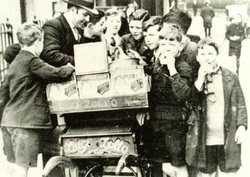
Italian immigrants played a crucial role in ice cream’s creation, firmly establishing themselves as key figures in its production and sale throughout Europe and America. In England, where many Italians emigrated after 1860, the notion of selling ice cream became strongly linked with Italian identity, especially among those from Naples and Rome who managed the majority of ice cream carts.
Thus, Italians have contributed not only pizza and pasta to the world but also ice cream!
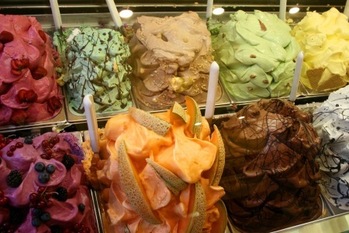
Semifreddo, which translates to semi-cold, is a light and mousse-like ice cream found in gelaterias. Although it’s lighter and softer, it is actually colder. If you get semifreddo in a cone, it will melt much quicker than gelato, as it is typically mounded high in the tub, much more so than gelato.
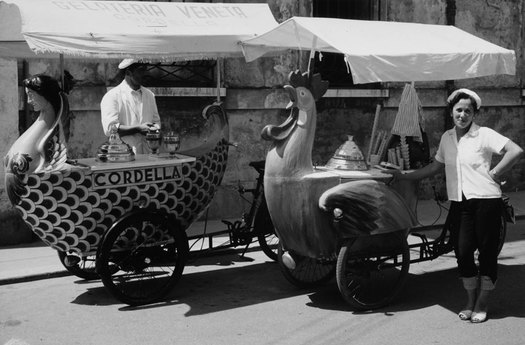
Gelato carts near Ravenna – 1957
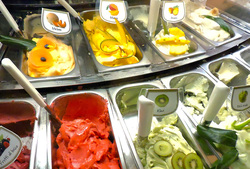
Gelato is crafted from a blend of milk, cream, various sugars, and flavors such as fresh fruit and nut purees. It is typically made with skim milk, generally resulting in lower calories, fat, and sugar content than American-style ice cream.
Typically, like any other ice cream, gelato requires a stabilizing base. Egg yolks are utilized in yellow custard-based gelato flavors, such as zabaione (also known as zabaglione) and crema al caramello (caramel cream).
In Italy, over 55% of gelato is hand-mixed, with a vast array of flavors available. Gelato shops often operate during lunchtime when most other shops and restaurants are closed. Thus, if you’re feeling hungry, you can either visit a bar (akin to a breakfast/lunch bar), many of which also offer gelato, or head to a gelateria! The same applies to the evening when numerous restaurants don’t open until 7:30 or 8:00 pm, making gelato a delightful option for kids around 5 o’clock without spoiling dinner.
You can order gelato in a small cone or in a cup, but there are a few important things to consider. First, inform the cassiere (cashier) about your order—how many cones or cups, how many flavors—then pay for it. The cassiere will provide you with a receipt. Afterward, take this receipt to the person scooping the gelato (usually, though not always, these are different individuals). Then you can specify whether to have a cup (coppa, coppe for plural) or cone (cono, coni for plural). If you’d like a small portion, simply ask for “piccolo,” and for a large one, you can say “grande.” To mix flavors, state “mezzo _____ e mezzo ____” for “half chocolate and half vanilla” or any other combination you prefer. It’s quite normal to request two flavors in a single cup.
Here are some flavor names:
Chocolates:
- cioccolato fondente (cho-koh-LAH-toh fawn-DEN-teh)—very dark chocolate
- cioccolato al latte (cho-koh-LAH-toh ahl LAH-tay)—milk chocolate
- bacio (BAH-cho)—named after hazelnut/chocolate candies from Perugia
- gianduja or gianduia (jahn-DOO-yah)—a creamy mixture of milk chocolate and hazelnut
- cioccolato all’arancia (cho-koh-LAH-toh ahl-ah-RAHN-cha)—dark chocolate and orange
- cioccolato con peperoncini (cho-koh-LAH-toh kohn pep-pehr-ohn-CHEE-nee)—dark chocolate infused with hot pepper
Nuts:
- pistacchio (pee-STAHK-yoh)—pistachio
- mandorla (mahn-DOOR-lah)—almond
- nocciola (noh-CHO-lah)—hazelnut (no chocolate)
- castagna (kahs-TAHN-yah)—chestnut
- fior di latte (FYOR dee LAH-tay)—sweet cream
- crema (KREH-mah)—vanilla egg custard
- zabaione (zah-bah-YOH-nay)—egg yolk custard with sweet Marsala wine
- cocco (KOH-koh)—coconut (my personal favorite)
- caffè (kah-FAY)—espresso
Fruits:
- amarena (ah-mah-RAY-nah)—fior di latte and sour cherries
- fragola (FRAH-go-lah)—strawberry
- lampone (lahm-POH-nay)—raspberry (often paired with dark chocolate)
- limone (lee-MOH-nay)—lemon
- lime (LEE-may)—lime
- mandarino (mahn-dah-REE-noh)—mandarin orange
- melone (meh-LOH-nay)—melon
- albicocca (al-bee-KOH-kah)—apricot
- fico (FEE-koh)—fig
- tarocco (tah-ROH-koh)—blood orange
- frutti di bosco (FROO-tee dee BOHS-koh)—literally “fruits of the forest,” often blueberries and blackberries
- mela (MEH-lah)—apple
- pera (PEH-rah)—pear
- pesca (PEHS-kah)—peach
Miscellaneous:
- zuppa inglese (TSOO-pah een-GLAY-zay)—English “trifle,” a custard/cookie crumble
- riso (REE-zoh)—rice pudding
- malaga (mah-LAH-gah)—rum raisin
- stracciatella (strah-cha-TEL-lah)—chocolate shards in fior di latte
- liquirizia (lee-kwee-REE-tzee-ah)—black licorice
- cannella (kah-NEL-lah)—cinnamon
- puffo (POOF-foh)—meaning “Smurf,” typically black licorice or bubblegum
- Viagra—herbs thought to act as an aphrodisiac, not the actual medication
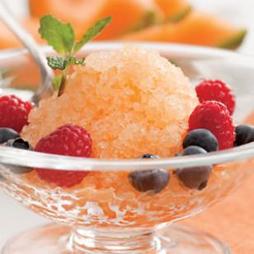
Granita (or granita Siciliana) is a semi-frozen dessert made from sugar, water, and various flavorings. It originated in Sicily and is now prevalent throughout Italy in varying forms. Although it resembles sorbet and Italian ice, granita possesses a coarser and more crystalline texture, which fluctuates between towns and even regions. The appealing texture results from various freezing techniques used. The smoother ones are produced in a gelato machine, while the coarser varieties involve minimal agitation before being scraped or shaved to create crystal-like ice. While the texture differs from creamier ice cream and denser sorbet, it remains distinctively delightful.
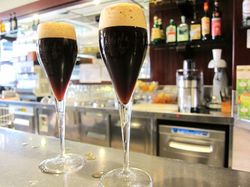
- 1 shot of espresso
- Sugar syrup (or a dash of superfine sugar)
- 4 small, 3/4-inch ice cubes
Shake the hot espresso, ice, and sugar syrup vigorously until the ice nearly melts—indicated by the sound of the cubes. Strain into a stemmed glass. For best results, prepare only two or three servings at a time.

Biscuit Tortoni is an ice cream dessert crafted using eggs and egg whites mixed with heavy cream, typically sprinkled with minced almonds or topped with chopped cherries. This treat is thought to be named after an Italian café owner in 18th-century Paris. A childhood favorite of mine, you could find either spumoni or tortoni at any excellent Italian restaurant, and I always preferred tortoni for its delightful almond flavor.
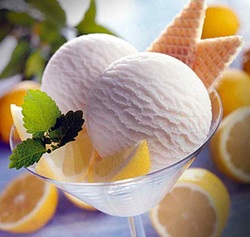
Sorbetto (sorbet in English) is a frozen dessert made from a simple syrup sweetened with water, flavored with fruit juice, purees, nectar, wine, or liqueur. Unlike gelato or ice cream, it does not contain milk or cream. While often deemed a low-fat alternative, the extra sweetness can inadvertently add calories. Many mistakenly believe that sorbetto is identical to American sherbet; in truth, sherbet involves dairy ingredients.
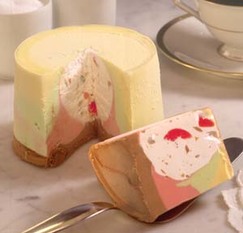
Spumone is an Italian dessert composed of layered gelato, whipped cream, candied fruit, and nuts. In America, it is frequently referred to as spumoni. This dessert is typically constructed in three layers—chocolate, pistachio, and cherry—where the chocolate layer contains chocolate shavings or crushed hazelnuts, the pistachio layer is studded with crushed pistachios, and the cherry layer includes candied cherries. Variations may include other fruit layers as well.
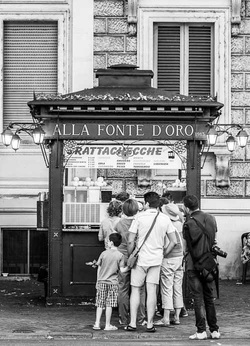
Grattachecca vendor in Rome |
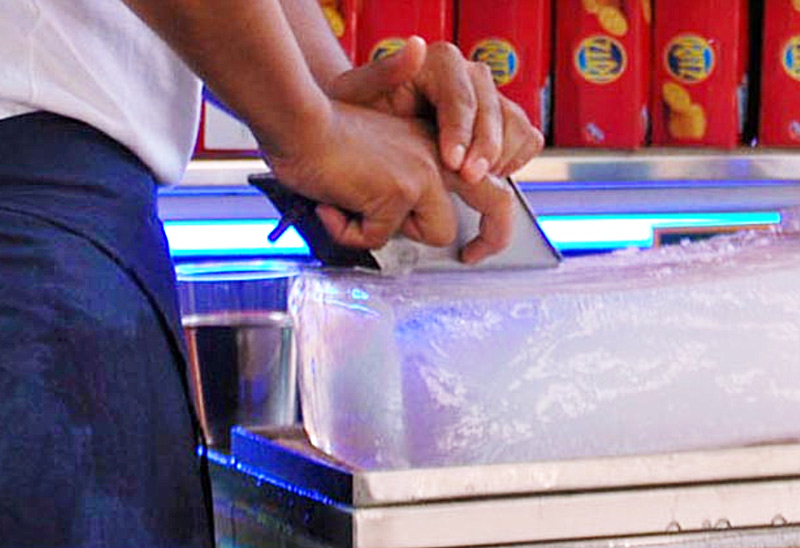
Vendor grating ice with a special scraping tool |
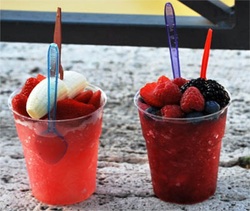
Grattachecca, or shaven ice, is a cherished frozen street treat in Rome. Vendors scrape large blocks of ice with metal shavers. Once the shaved ice is collected in a cup, flavored syrups and fruits are added. Common flavors are black cherry, tamarind, mint, barley water, coconut, or lemon. Interestingly, during the early 1900s, large blocks of ice was known as checca, initially used for cooling food and drinks. A creative vendor decided to grate the ice to create a refreshing drink, thus giving birth to the name grattachecca.
|
Cornetto
No, this is not the sweet horn-shaped bread; Cornetto is a brand of frozen dessert cones produced by Unilever under the Wall’s brand. Ranging from milk-based ice cream to vegetable fat-based desserts, it was first manufactured in Naples in 1976 by a company named Spica. Unilever acquired Spica and began marketing Cornetto throughout Europe, making it a well-known packaged ice cream brand in the UK and Ireland, with numerous flavors available in supermarkets and alimentari across Italy. |
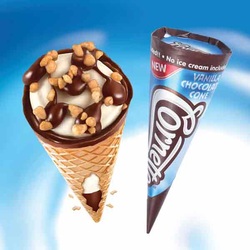
|
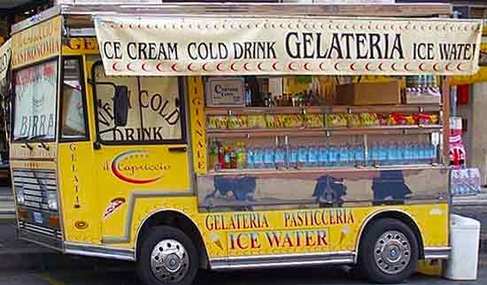
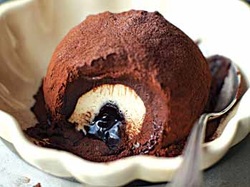
Translating to “truffle,” Tartufo is molded to resemble a large truffle. Crafted from two flavors of ice cream, it typically incorporates either fruit syrup or frozen fruit in the center, commonly raspberry, strawberry, or cherry. This frozen treat hails from Pizzo, Calabria. Melted chocolate is poured over the ice cream ball after cooling. The outer layer may be dusted with cinnamon or cocoa, mimicking the appearance of a real truffle, often rolled in nuts for added texture.
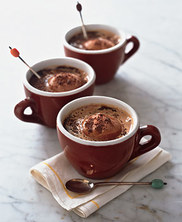
If you’re a fan of espresso, this is for you. An affogato (literally meaning “drowned” in Italian) consists of a scoop of vanilla gelato drowned in a shot of hot espresso. Variations may include extra liqueurs like amaretto for added flavor.
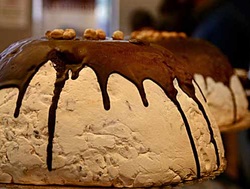
Zuccotto
Originating from Florence, Zuccotto is a semi-frozen dessert made with semifreddo, brandy, and sponge cake, typically enriched with espresso flavoring. Essentially, it’s an ice cream bombe that can be frozen and then thawed before serving, traditionally molded in a pumpkin-shaped form. The name combines zucca (pumpkin) and cotto (cooked), with some theorizing that it refers to zucetto (skullcap), reflecting the shape of this delightful dessert.
–Jerry Finzi
If you found this article enjoyable, please SHARE it and LIKE it on your favorite social media platforms. Ciao!
We also have pages on:
Twitter
Google+
Pinterest
Facebook
Copyright, 2015-2019, Jerry Finzi/GrandVoyageItaly.com – All rights reserved


